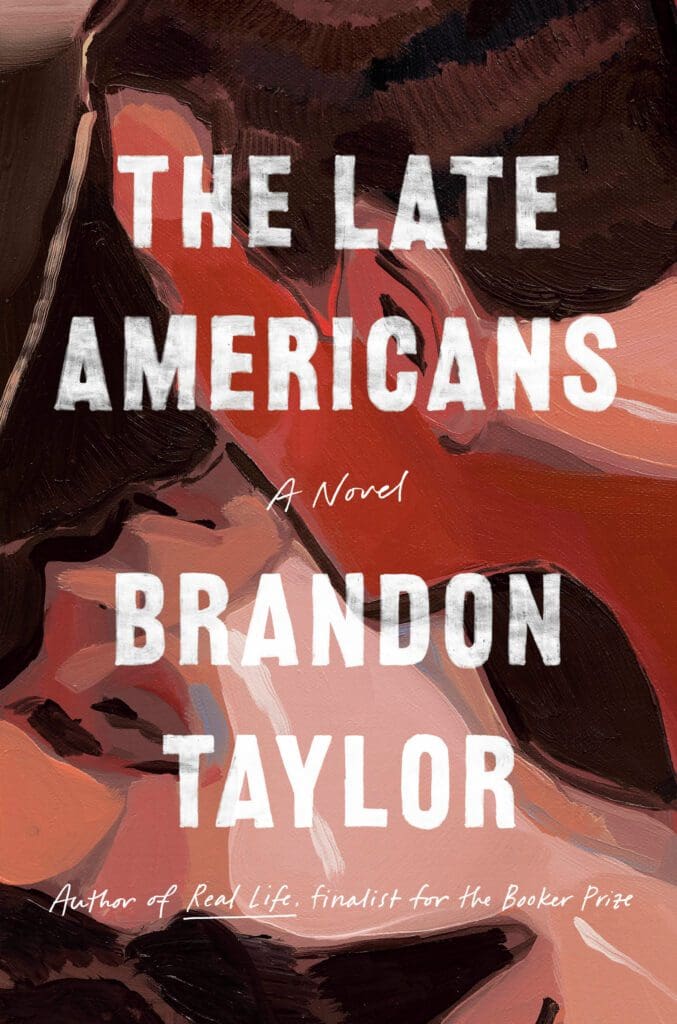The characters in Brandon Taylor’s The Late Americans (320 pages; Riverhead Books) are poets, dancers, painters, students, and townies, lovers, and exes, “upright beasts, walking on their hind legs, baying at electric moons.” Except for a few, they are in their twenties and on the brink of proper adulthood.
There is an engaging urgency in their lives and in Taylor’s new novel, his second after Real Life (2020), a Booker Prize finalist. The book, a novel-in-stories, deftly weaves the lives of students from the university with the community around it—Obama-era Iowa City—depicting where the two collide and recoil back into their separate worlds. And as the characters swirl in and out of each other’s lives, they form a tangled, awkward social web of acquaintances, friends, and partners particular to college towns.
Seamus, a student in an MFA poetry program implied to be the Iowa Writers’ Workshop (Taylor is a graduate of the Workshop), wants to write about the past, “the comic circumstances of life and the universe, and the whole dark mystery.” But in a tense, hilarious send-up of graduate workshops, the students’ poems are instead discussed in terms of social identity, historical accountability, and contemporary politics. At Seamus’s goading, the class devolves into accusations of prejudice and name-calling.
But it is often money more than sex, race, or gender that causes friction between characters. The students that need jobs to support themselves (Seamus works at a hospice) are separated from the ones who don’t. Goran, a Black music student adopted by a wealthy white family, is said to move “with wealth as though it were a different, better kind of element.” Money and class seep into the heart of relationships, including the relationship between artists and their art.
The students wrestle with what it means to be an artist within our economic system. A classmate insists to Fatima, a modern dance student, that dance and not her café job, is the real work. “It’s all work, you know,” Fatima answers. Does the labor of art for money make it another job, or is it something more noble? Perhaps art is distinguished, in the words of the sadistic, predatory dance professor Ólafur, by “empathy, passion, and pain.” But the pain is already plentiful in the lives of these young people. The artists aren’t ultimately in search of money or even happiness. They pursue their crafts because they simply have to. They want to be seen, heard, assured of their existence.
To read The Late Americans is an intensely intimate experience. It’s not just the sex. (So often in fiction, characters are clumsily harnessed to their bodies; it seems authors would prefer humans were floating vessels of thought and dialogue. Taylor’s late Americans are delightfully burdened by their bodies and desires.) Sex abounds, mostly between men, at times transactional, threatening, make-up, or mundane. Rather, it’s the little cruelties that the characters zip at each other, the fears they can hardly admit to themselves, the palpable loneliness among so many of them. The characters are hyperaware of seeing and being seen. Seamus imagines the world as a museum exhibit or dollhouse with God peering down; Fyodor, who works at a meatpacking plant, dislikes watching movies because they are fake versions of reality. Ivan records and uploads pornographic videos of himself to earn extra cash, but when Timo, Fyodor’s boyfriend, views the content, he notes, “There was something fiercely forbidding in watching Ivan, as though he were unwilling to let the viewer escape what they had done by trying to include themselves in his pleasure.”
Bea is the narrative’s anomaly, unconnected to the other characters. Alone in her apartment she creates dioramas filled with fiberboard furniture and tiny humans and feels that there are eyes always looking at her from the dark—perhaps the same incorporeal eyes that another character senses in the novel’s final chapter. From downtown, Bea watches children on a playground and sees one get badly hurt. They all start screaming but are ignored by their parents. Who is looking out for these children? The world ahead of them is harsh, and like the diseased trees that line the streets of Iowa City, the weak can be replaced. Young people are in a system that favors those who advanced early—prodigies with the hours, the investments, the generations who amassed wealth. They are failed by the professors who overlook, patronize, and prey on them. But against the hostile world, the late Americans are looking out for each other, as when Noah, one of the dance students, simply looks at Bea from across the street one day. It’s a tiny encounter, but to Bea, “she was set apart, because she had been seen. Noted.”
Despite how abject some of its characters are, how bad they accidentally hurt each other and how purposefully they sometimes do it, The Late Americans is an oddly comforting novel. If its characters are straining to be seen, Taylor sees them. The net of connected characters and moments is the whole point of the novel—the impermanence, the coincidental affinities that exist among young people inhabiting the same spaces. It may not last very long—“late” meaning soon to come to an end. Some are about to fail, some are about to become very rich. Some are never going to see each other again. But for now they are together, burning and brilliant.

